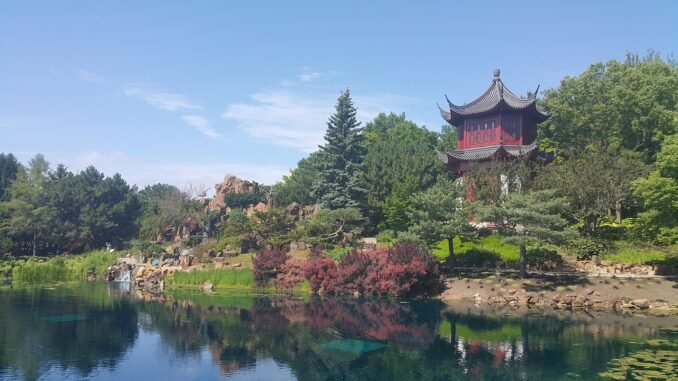
Did you know one of the world’s largest urban green spaces Montreal Botanical Garden, spans 75 hectares? This stunning oasis in the heart of the city is home to over 22,000 plant species, making it a paradise for nature lovers.
As part of the Space for Life museum district, this iconic destination blends education with breathtaking outdoor gardens. From vibrant seasonal exhibits to serene greenhouses, there’s something to explore year-round.
Families and solo adventurers alike flock here, drawn by its accessibility via public transit and immersive displays like the annual butterfly exhibit. Whether you seek tranquility or discovery, this area promises an unforgettable experience.
A Glimpse into the Past: The History of Montreal Botanical Garden
In 1931, amid economic hardship, a green vision took root in Quebec. Mayor Camillien Houde championed the jardin botanique as a beacon of hope during the Great Depression. Spanning 75 hectares, it became one important sanctuary for both people and plants.
Designed by horticulturist Henry Teuscher and botanist Fr. Marie-Victorin, the space blended science with artistry. Lucien F. Kéroack’s Art Deco building gave the administration hub its iconic style, still admired today.
During WWII, the gardens adapted to wartime needs, growing medicinal herbs. By 2008, its cultural impact earned it a national historic designation. Original missions—education and endangered species protection—still guide its work.
- Community ties: Free access passes for locals honor its Depression-era roots.
- Architectural legacy: Kéroack’s designs harmonize functionality with beauty.
- Modern conservation: Research here aids global biodiversity efforts.
From a relief project to a national historic treasure, the jardin botanique proves resilience and beauty grow hand in hand.
Gardens & Greenhouses: A World of Botanical Wonders
Step into a living tapestry of global flora, where each garden tells a unique story. The greenhouses replicate ecosystems from tropical rainforests to arid deserts, while outdoor spaces showcase meticulously designed cultural landscapes.
The Enchanting Chinese Garden
Inspired by Ming Dynasty aesthetics, this area blends pavilions, koi ponds, and rare bamboo species. Stone pathways wind past weeping willows, offering quiet corners for reflection.
The Serene Japanese Garden
Zen philosophy shapes every element here. Pruned maples frame a tea house, while raked gravel symbolizes water. Seasonal cherry blossoms draw crowds each spring.
The First Nations Garden
Celebrating Indigenous traditions, this space features medicinal plants like sweetgrass and sage. Interpretive signs share ancestral knowledge of land stewardship.
The Alpine Garden and More
Delicate arctic blooms thrive in the rock garden’s microclimates. Nearby, a poisonous plant area warns visitors about toxic specimens like deadly nightshade.
| Garden | Key Features | Best Time to Visit |
|---|---|---|
| Chinese | Bamboo groves, pagodas | May–October |
| Japanese | Cherry blossoms, koi ponds | April, September |
| First Nations | Medicinal plants, storytelling | June–August |
| Alpine | Arctic flora, rock formations | July–August |
Don’t miss the adjacent arboretum, home to 7,000+ trees. From towering redwoods to delicate bonsai, it’s a testament to nature’s resilience.
Planning Your Visit: Tips for Exploring Montreal Botanical Garden
Ready to explore one of Canada’s most stunning green spaces? Located at 4101 Sherbrooke Street East, this urban oasis is easily accessible via Pie-IX or Viau metro stations. Bike racks and lockers are available for visitors who prefer cycling or need storage.
Each season offers unique charm. Spring bursts with tulips and cherry blossoms, while winter invites cozy greenhouse tours. Check the table below to time your visit perfectly:
| Season | Highlights | Tips |
|---|---|---|
| Spring | Tulip displays, Japanese cherry blooms | Weekday mornings avoid crowds |
| Summer | Rose garden peak, butterfly exhibit | Bring sunscreen and water |
| Fall | Maple foliage, harvest themes | Layer clothing for changing temps |
| Winter | Tropical greenhouses, festive lights | Combo tickets with Biodome |
Save with combo tickets for the Insectarium or Biodome. Photography is allowed, but tripods need permits. Picnics are welcome in designated outdoor gardens—pack local treats from the on-site café!
Extend your day with nearby attractions like the Olympic Stadium, just a 10-minute walk from Sherbrooke Street East. Whether you’re a solo explorer or a family, these tips ensure a seamless adventure.
Conclusion: Why Montreal Botanical Garden is a Must-See
Few places blend education and nature as beautifully as this urban oasis. Across 10+ themed gardens, artistry meets science—from tranquil Japanese maples to vibrant tropical collections.
It’s one important destination for families and solo explorers alike. Interactive displays make learning fun, while seasonal shifts ensure no two visits are the same. Rivaling the best botanical gardens in the world, it’s a cornerstone of Canadian culture.
Plan your trip today to catch current exhibits. Whether it’s spring blossoms or winter greenhouse tours, every season unveils new wonders here.
FAQ
Where is the Montreal Botanical Garden located?
It’s situated at 4101 Sherbrooke Street East, easily accessible from downtown.
What are the opening hours?
Hours vary by season. Check the official website for current schedules.
Are there guided tours available?
Yes! Both self-guided and expert-led tours are offered throughout the year.
Can I bring my pet?
Only service animals are permitted inside the gardens and greenhouses.
Is photography allowed?
Absolutely! Capture the stunning landscapes, but tripods may require special permission.
Are there dining options on-site?
Yes, cafés and picnic areas are available for visitors to enjoy.
What’s the best time to visit Montreal Botanical Garden?
Spring through fall offers vibrant blooms, while winter features magical light displays.
Is the venue wheelchair accessible?
Most areas are accessible, with ramps and paved pathways for easy navigation.
